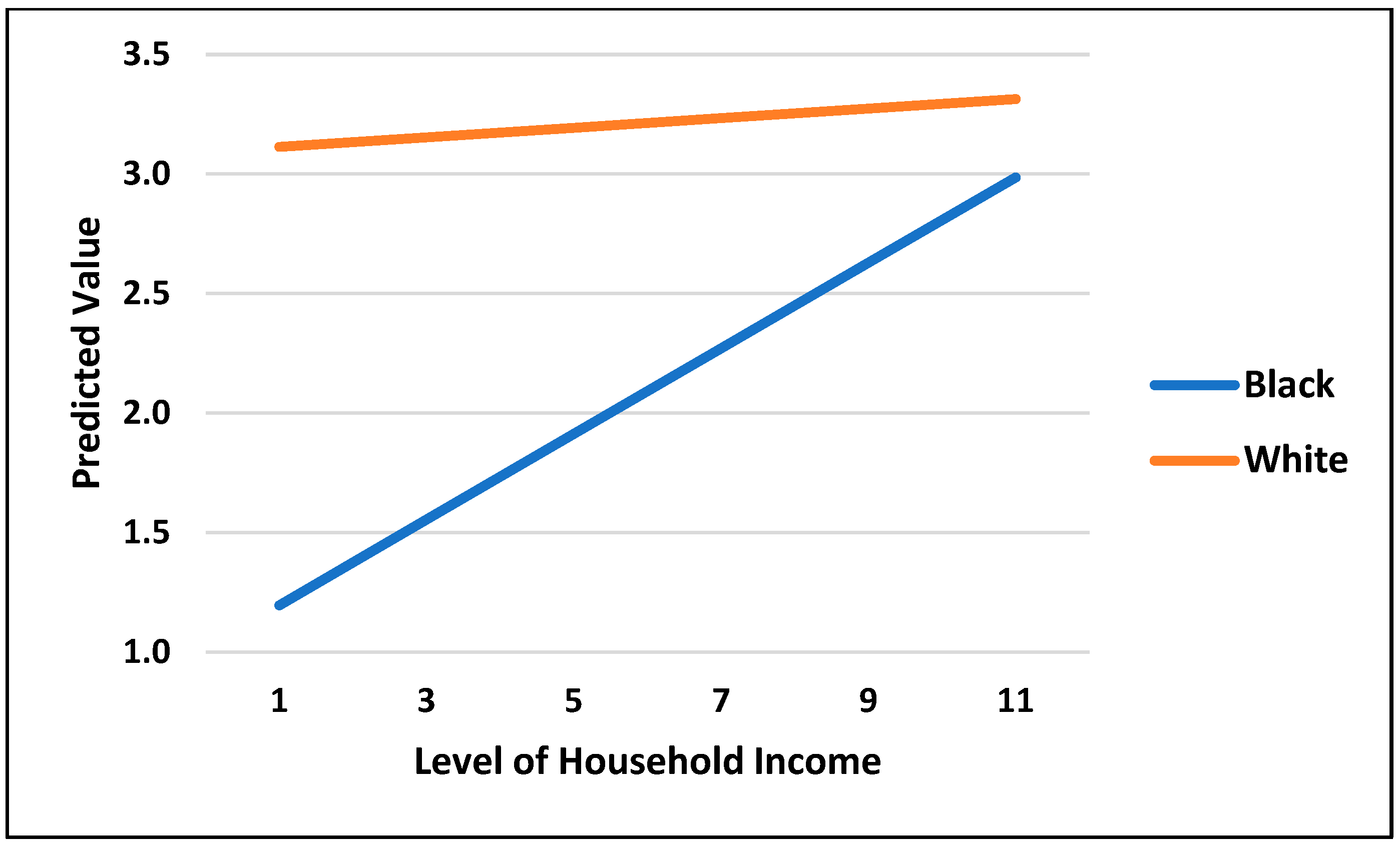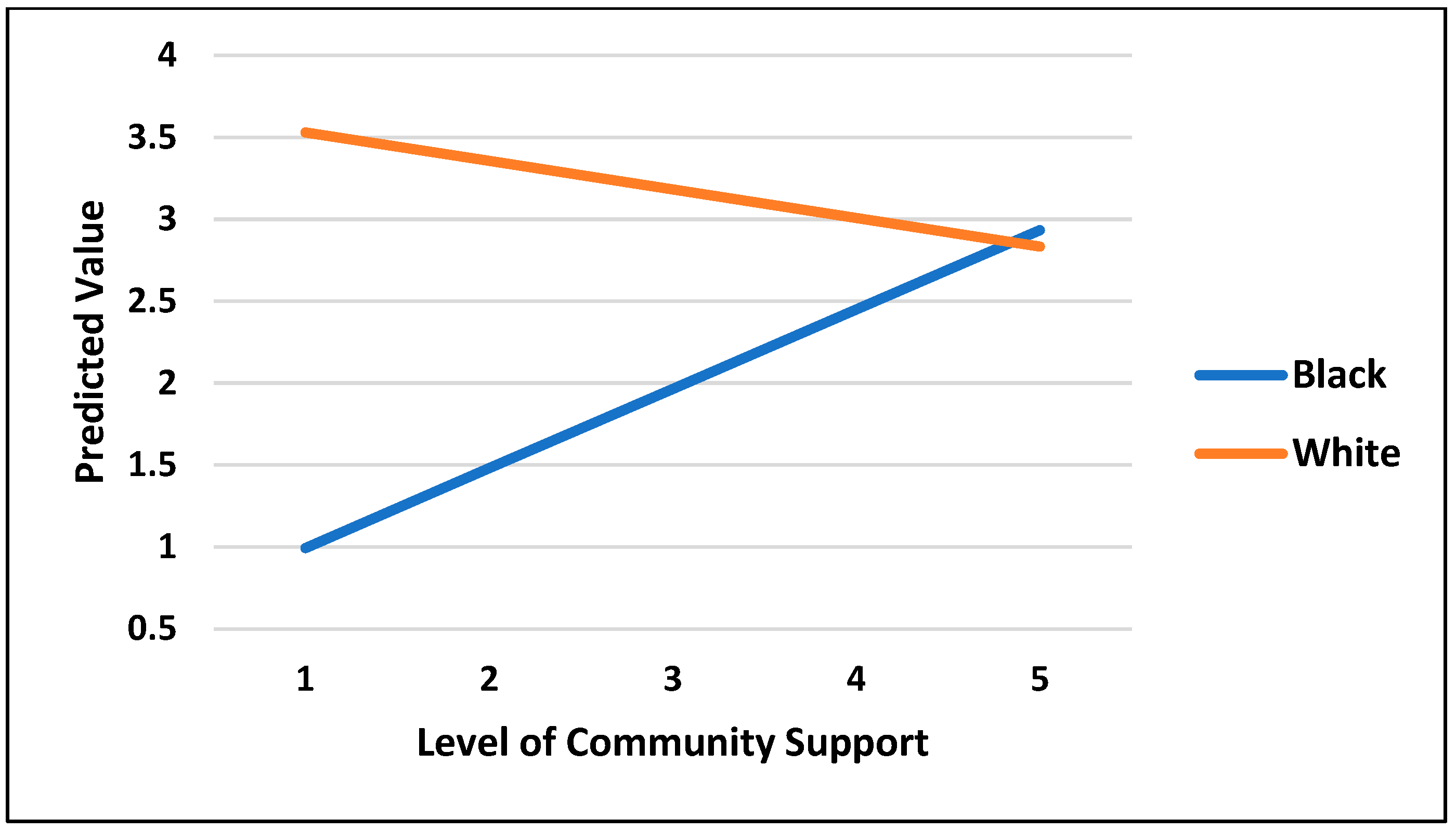Breastfeeding and Intersectionality in the Deep South: Race, Class, Gender and Community Context in Coastal Mississippi
Abstract
1. Introduction
2. Results
Interpretations of Regression Results
3. Discussion
4. Materials and Methods
Analytic Approach
5. Conclusions
Author Contributions
Funding
Institutional Review Board Statement
Informed Consent Statement
Data Availability Statement
Acknowledgments
Conflicts of Interest
References
- Mississippi State Department of Health. Health Equity. Available online: https://msdh.ms.gov/page/44,0,236.html (accessed on 17 October 2024).
- Mississippi State Department of Health. State of the State: Annual Mississippi Health Disparities & Inequalities Report. July 2023. Available online: https://msdh.ms.gov/page/resources/20313.pdf (accessed on 17 October 2024).
- Gleason, K.; Makosiej, M. Commissioned Paper Current State of Health, Community Resilience, and Cohesion in the Gulf of Mexico Region. In Advancing Health and Resilience in the Gulf of Mexico Region: A Roadmap for Progress; National Library of Medicine: Bethesda, MD, USA, 2022. Available online: https://www.ncbi.nlm.nih.gov/books/NBK600389/#pz147-1 (accessed on 17 October 2024).
- March of Dimes Peristats. Reports: 2024 March of Dimes Report Card for Mississippi. Available online: https://www.marchofdimes.org/peristats/reports/mississippi/report-card (accessed on 17 October 2024).
- Binns, C.; Lee, M.; Low, W.Y. The Long-Term Public Health Benefits of Breastfeeding. Asia Pacific J. Pub. Health 2016, 28, 7–14. [Google Scholar] [CrossRef] [PubMed]
- Prentice, A.M. Breastfeeding in the Modern World. Ann. Nutr. Metab. 2022, 78 (Suppl. 2), 29–38. [Google Scholar] [CrossRef] [PubMed]
- March of Dimes. State Summary for United States. Available online: https://www.marchofdimes.org/peristats/state-summaries/united-states?top=3®=99&lev=1&stop=55&obj=3&slev=4 (accessed on 17 October 2024).
- Meek, J.Y.; Noble, L. Policy Statement: Breastfeeding and the Use of Human Milk. Pediatrics 2022, 150, e2022057988. [Google Scholar] [CrossRef]
- World Health Organization. International Code of Marketing of Breast-Milk Substitutes. Available online: https://www.who.int/publications/i/item/9241541601 (accessed on 18 March 2024).
- United Nations Children’s Fund. Infant and Young Child Feeding. Innocenti Declaration 2005. pp. 1–9. Available online: https://www.unicef-irc.org/files/documents/d-3188-Innocenti-Declaration-200.pdf (accessed on 17 October 2024).
- Hancock, A.-M. Solidarity Politics for Millennials: A Guide for Ending the Oppression Olympics; Palgrave Macmillan: New York, NY, USA, 2011. [Google Scholar]
- Harris, A.; Leonardo, Z. Intersectionality, Race-Gender Subordination, and Education. Rev. Res. Educ. 2018, 42, 11–27. [Google Scholar] [CrossRef]
- Ernst, R.; Luft, R.E. Welfare, Poverty and Low-Wage Employment. In The Oxford Handbook of U.S. Women’s Social Movement Activism; McCammon, H.J., Banaszak, L.A., Taylor, V., Reger, J., Eds.; Oxford University Press: New York, NY, USA, 2017. [Google Scholar]
- Hancock, A.-M. Empirical Intersectionality: A Tale of Two Approaches Symposium Issue: Critical Race Theory and Empirical Methods. UC Irvine Law Rev. 2013, 3, 259–296. [Google Scholar]
- Butler, M.S.; Smart, B.P.; Watson, E.J.; Narla, S.S.; Keenan-Devlin, L.U.S. Breastfeeding Outcomes at the Intersection: Differences in Duration Among Racial and Ethnic Groups with Varying Educational Attainment in a Nationally Representative Sample. J. Human Lact. 2023, 39, 722–732. [Google Scholar] [CrossRef]
- Hauck, Y.L.; Bradfield, Z.; Kuliukas, L. Women’s Experiences with Breastfeeding in Public: An Integrative Review. Women Birth 2021, 34, e217–e227. [Google Scholar] [CrossRef]
- Standish, K.R.; Parker, M.G. Social Determinants of Breastfeeding in the United States. Clin. Therap. 2022, 44, 186–192. [Google Scholar] [CrossRef]
- Louis-Jacques, A.; Deubel, T.F.; Taylor, M.; Stuebe, A.M. Racial and Ethnic Disparities in U.S. Breastfeeding and Implications for Maternal and Child Health Outcomes. Semin. Perin. 2017, 41, 299–307. [Google Scholar] [CrossRef]
- Parker, M.G.; Stellwagen, L.M.; Noble, L.; Kim, J.H.; Poindexter, B.B.; Puopolo, K.M. Promoting Human Milk and Breastfeeding for the Very Low Birth Weight Infant. Pediatrics 2021, 148, e2021054272. [Google Scholar] [CrossRef]
- Briere, C.-E.; McGrath, J.; Cong, X.; Cusson, R. An Integrative Review of Factors that Influence Breastfeeding Duration for Premature Infants after NICU Hospitalization. J. Obstet. Gynecol. Neonatal Nurs. 2014, 43, 272–281. [Google Scholar] [CrossRef] [PubMed]
- Colaizy, T.T.; Saftlas, A.F.; Morriss, F.H., Jr. Maternal Intention to Breastfeed and Breastfeeding Outcomes in Term and Preterm Infants: Pregnancy Risk Assessment Monitoring System (PRAMS), 2000–2003. Public Health Nutr. 2012, 15, 702–710. [Google Scholar] [CrossRef]
- Hoban, R.; Bigger, H.; Patel, A.L.; Rossman, B.; Fogg, L.F.; Meier, P. Goals for Human Milk Feeding in Mothers of Very Low Birth Weight Infants: How Do Goals Change and Are They Achieved During the NICU Hospitalization? Breastfeed Med. 2015, 10, 305–311. [Google Scholar] [CrossRef]
- Hadisuyatmana, S.; Has, E.M.M.; Sebayang, S.K.; Efendi, F.; Astutik, E.; Kuswanto, H.; Arizona, I.K.L.T. Women’s Empowerment and Determinants of Early Initiation of Breastfeeding: A Scoping Review. J. Ped. Nur. 2021, 56, e77–e92. [Google Scholar] [CrossRef] [PubMed]
- Petit, M.; Smart, D.A.; Sattler, V.; Wood, N.K. Examination of Factors That Contribute to Breastfeeding Disparities and Inequities for Black Women in the US. J. Nutri. Edu. Behav. 2021, 53, 977–986. [Google Scholar] [CrossRef] [PubMed]
- Black, R.; McLaughlin, M.; Giles, M. Women’s Experience of Social Media Breastfeeding Support and Its Impact on Extended Breastfeeding Success: A Social Cognitive Perspective. Brit. J. Health Psych. 2020, 25, 754–771. [Google Scholar] [CrossRef]
- Chang, Y.S.; Beake, S.; Kam, J.; Lok, K.Y.W.; Bick, D. Views and Experiences of Women, Peer Supporters and Healthcare Professionals on Breastfeeding Peer Support: A Systematic Review of Qualitative Studies. Midwifery 2022, 108, 103299. [Google Scholar] [CrossRef]
- Gavine, A.; Marshall, J.; Buchanan, P.; Cameron, J.; Leger, A.; Ross, S.; Murad, A.; McFadden, A. Remote Provision of Breastfeeding Support and Education: Systematic Review and Meta-Analysis. Matern. Child Nutri. 2021, 18, e13296. [Google Scholar] [CrossRef]
- Lebron, C.N.; St. George, S.M.; Eckembrecher, D.G.; Alvarez, L.M. “Am I Doing This Wrong?” Breastfeeding Mothers’ Use of an Online Forum. Matern. Child Nutri. 2019, 16, e12890. [Google Scholar] [CrossRef]
- Meedya, S.; Win, K.; Yeatman, H.; Fahy, K.; Walton, K.; Burgess, L.; McGregor, D.; Shojaei, P.S.; Wheatley, E.; Halcomb, E. Developing and Testing a Mobile Application for Breastfeeding Support: The Milky Way Application. Women Birth 2021, 34, e196–e203. [Google Scholar] [CrossRef]
- Moon, H.; Woo, K. An Integrative Review on Mothers’ Experiences of Online Breastfeeding Peer Support: Motivations, Attributes and Effects. Matern. Child Nutri. 2021, 17, e13200. [Google Scholar] [CrossRef] [PubMed]
- Morse, H.; Brown, A. Accessing Local Support Online: Mothers’ Experiences of Local Breastfeeding Support Facebook Groups. Matern. Child Nutri. 2021, 17, e13227. [Google Scholar] [CrossRef] [PubMed]
- Uscher-Pines, L.; Ghosh-Dastidar, B.; Bogen, D.L.; Ray, K.N.; Demirci, J.R.; Mehrotra, A.; Kapinos, K.A. Feasibility and Effectiveness of Telelactation Among Rural Breastfeeding Women. Acad. Pedi. 2020, 20, 652–659. [Google Scholar] [CrossRef] [PubMed]
- Bartkowski, J.P.; Kohler, J.; Xu, X.; Collins, T.; Roach, J.B.; Newkirk, C.; Klee, K. Racial Differences in Breastfeeding on the Mississippi Gulf Coast: Making Sense of a Promotion-Prevalence Paradox with Cross-Sectional Data. Healthcare 2022, 10, 2444. [Google Scholar] [CrossRef]
- Snyder, K.; Hulse, E.; Dingman, H.; Cantrell, A.; Hanson, C.; Dinkel, D. Examining Supports and Barriers to Breastfeeding Through a Socio-Ecological Lens: A Qualitative Study. Int. Breastf. J. 2021, 16, 52. [Google Scholar] [CrossRef]
- Segura-Perez, S.; Hromi-Fiedler, A.; Adnew, M.; Nyhan, K.; Perez-Escamilla, R. Impact of Breastfeeding Interventions Among United States Minority Women on Breastfeeding Outcomes: A Systematic Review. Int. J. Equity. Health 2021, 20, 72. [Google Scholar] [CrossRef]
- Ngoenthong, P.; Sansiriphun, N.; Fongkaew, W.; Chaloumsuk, N. Integrative Review of Fathers’ Perspectives on Breastfeeding Support. J. Obst. Gyn. Neon. Nurs 2020, 49, 16–26. [Google Scholar] [CrossRef] [PubMed]
- Ogbo, F.A.; Akombi, B.J.; Ahmed, K.Y.; Rwabilimbo, A.G.; Ogbo, A.O.; Uwaibi, N.E.; Ezeh, O.K.; Agho, K.E.; on behalf of the Global Maternal and Child Health Research Collaboration (GloMACH). Breastfeeding in the Community—How Can Partners/Fathers Help? A Systematic Review. Int. J. Environ. Res. Public Health 2020, 17, 413. [Google Scholar] [CrossRef]
- Tang, X.; Patterson, P.; MacKenzie-Shalders, K.; van Herwerden, L.A.; Bishop, J.; Rathbone, E.; Honeyman, D.; Reidlinger, D.P. Workplace Programmes for Supporting Breast-feeding: A Systematic Review and Meta-Analysis. Public Health Nutr. 2021, 24, 1501–1513. [Google Scholar] [CrossRef]
- Quinn, P.; Tanis, S.L. Attitudes, Perceptions, and Knowledge of Breastfeeding Among Professional Caregivers in a Community Hospital. Nurs. Women Health 2020, 24, 77–83. [Google Scholar] [CrossRef]
- Thomson, J.L.; Tussing-Humphreys, L.M.; Goodman, M.H.; Landry, A.S.; Olender, S.E. Low Rate of Initiation and Short Duration of Breastfeeding in a Maternal and Infant Home Visiting Project Targeting Rural, Southern, African American Women. Int. Breastfeed. J. 2017, 12, 15. [Google Scholar] [CrossRef] [PubMed]
- Bartkowski, J.P.; Klee, K.; Xu, X.; Roach, J.B.; Jones, S.K. It Takes a Village: How Community-Based Peer Support for Breastfeeding Bolsters Lactation Prevalence Among Black Mississippians on the Gulf Coast. Pediatr. Rep. 2024, 16, 1064–1076. [Google Scholar] [CrossRef] [PubMed]


| n | Percent | Mean | SD | |
|---|---|---|---|---|
| Breastfeeding Network Prevalence | - | - | 2.48 | 1.58 |
| African American | 120 | 49.79 | - | |
| White | 121 | 50.21 | - | - |
| Household income in 2018 | - | - | 5.34 | 3.07 |
| Community Support (index) | - | - | 3.26 | 0.99 |
| Age | - | - | 43.66 | 17.00 |
| Education | - | - | 5.07 | 1.53 |
| Employed | 129 | 53.53 | - | - |
| Not working/Other | 112 | 46.47 | - | - |
| Variable | Model 1 | Model 2 | Model 3 | Model 4 | ||||
|---|---|---|---|---|---|---|---|---|
| African American (White = reference) | −1.216 | *** | −1.211 | *** | −1.049 | *** | −0.994 | *** |
| Household income | 0.129 | * | 0.020 | 0.085 | * | 0.080 | ||
| Household income x AA | 0.159 | ** | ||||||
| Community support (index) | 0.264 | ** | −0.174 | |||||
| Community support x AA | 0.659 | ** | ||||||
| Age | −0.006 | −0.006 | −0.008 | −0.010 | ||||
| Education | 0.076 | 0.081 | 0.112 | 0.139 | ||||
| Employed (other = reference) | −0.118 | −0.049 | −0.055 | 0.024 | ||||
| Intercept | 2.371 | *** | 2.940 | *** | 1.512 | * | 2.930 | *** |
| F | 16.911 | *** | 15.649 | *** | 12.166 | *** | 12.585 | *** |
| R2 | 0.265 | 0.286 | 0.235 | 0.271 | ||||
Disclaimer/Publisher’s Note: The statements, opinions and data contained in all publications are solely those of the individual author(s) and contributor(s) and not of MDPI and/or the editor(s). MDPI and/or the editor(s) disclaim responsibility for any injury to people or property resulting from any ideas, methods, instructions or products referred to in the content. |
© 2025 by the authors. Licensee MDPI, Basel, Switzerland. This article is an open access article distributed under the terms and conditions of the Creative Commons Attribution (CC BY) license (https://creativecommons.org/licenses/by/4.0/).
Share and Cite
Bartkowski, J.P.; Klee, K.; Xu, X.; Roach, J.B.; Jones, S. Breastfeeding and Intersectionality in the Deep South: Race, Class, Gender and Community Context in Coastal Mississippi. Women 2025, 5, 21. https://doi.org/10.3390/women5020021
Bartkowski JP, Klee K, Xu X, Roach JB, Jones S. Breastfeeding and Intersectionality in the Deep South: Race, Class, Gender and Community Context in Coastal Mississippi. Women. 2025; 5(2):21. https://doi.org/10.3390/women5020021
Chicago/Turabian StyleBartkowski, John P., Katherine Klee, Xiaohe Xu, Jacinda B. Roach, and Shakeizia (Kezi) Jones. 2025. "Breastfeeding and Intersectionality in the Deep South: Race, Class, Gender and Community Context in Coastal Mississippi" Women 5, no. 2: 21. https://doi.org/10.3390/women5020021
APA StyleBartkowski, J. P., Klee, K., Xu, X., Roach, J. B., & Jones, S. (2025). Breastfeeding and Intersectionality in the Deep South: Race, Class, Gender and Community Context in Coastal Mississippi. Women, 5(2), 21. https://doi.org/10.3390/women5020021









